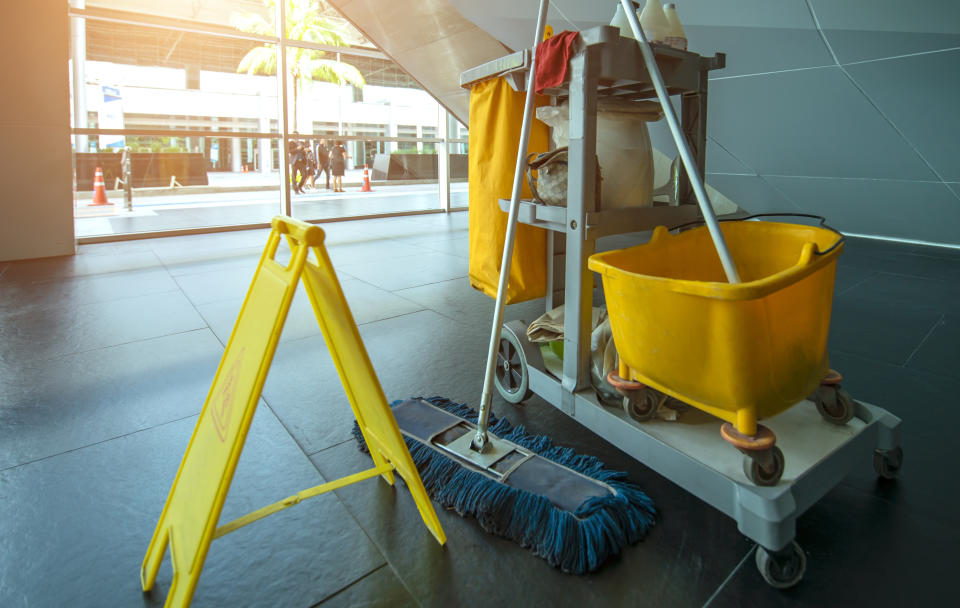5 health hazards in the workplace you’re probably overlooking
When you think of workplace health hazards for people living with chronic obstructive pulmonary disease (COPD) or other lung diseases, your first thought may be the poor air quality you’d find in a steel mill or coal mine. But there are plenty of potential problems for people living with COPD, even if they are in a traditional office-based environment, says Neil Schachter, MD, a pulmonologist at Mount Sinai Hospital in New York City.
Here, five health hazards in the workplace to look out for — and ways to stay protected.
Office air quality

“Every office environment has a potential for problems, because on any given day, the air in an office can c`ontain alcohol from adhesives, ketones from paint, phthalates from plastics and esters from floor coverings,” says Schachter. All of these may trigger an exacerbation of COPD. The level of these irritants in your office, he adds, depends on its HVAC system (the heating, ventilation and air conditioning system).
In a properly maintained office, the environment is a mixture of fresh air and recirculated air. But since windows rarely open in modern buildings, if it’s not working properly, levels of these pollutants will build up. “As a result, if you have COPD you may experience an increased shortness of breath while you’re there, and may even develop a dangerous exacerbation,” explains Schachter.
What to do: If you and co-workers experience symptoms, speak to your supervisor about your concerns and ask management to look into HVAC maintenance. “Cleaning and repairing it will help everyone,” says Schachter. He also recommends using a desktop air purifier, which can be purchased in stores like Target or Walmart, or online.
When you get home each evening, Schachter also suggests hopping in the shower and washing your hair immediately to remove pollutants before they drift into your airways.
Photocopiers and ink

Office workers in information fields like publishing or data processing, as well as administrative assistants, have the highest rates of chronic obstructive pulmonary disease at 3.3 percent, according to a paper published this May in the Journal of the American Medical Association. (By comparison, coal miners are at 3.1 percent.) This is probably due to airway irritants including dusts, gases and fumes that arise from equipment like photocopiers and ink, says Rochester.
What to do: If you think there may be a connection, Rochester recommends keeping a symptom diary. “If you find that you’re using your rescue inhaler three times a day during the work week, but not on the weekend, then it’s clear it’s work-related,” she says.
You can also use a peak expiratory flow monitor — a handheld device that measures how fast you exhale — to check for differences between work and home. If it becomes clear that symptoms are worse not just at work, but when you’re around specific things such as the office photocopy machine, you can work with your employer to avoid exposure, and when necessary, use an N95 mask.
Germs

Many COPD flare-ups are triggered by upper respiratory infections such as the common cold or flu, according to the American Thoracic Society. But working in close quarters with others can raise your risk of getting sick.
What to do: The best way to protect yourself is to get a flu vaccine every year. A 2019 study published in the medical journal Chest found that people with COPD who got one had almost a 40 percent lower risk of being hospitalized with flu-related complications. You should also get the pneumococcal vaccine (Pneumovax 23), as people with COPD are also at higher risk of developing pneumonia.
You can help protect yourself at work by washing your hands frequently, for at least 20 seconds, with soap and water, or by using a hand sanitizer that contains at least 60 percent alcohol. The CDC also recommends that you routinely disinfect frequently touched objects and surfaces like your office door, computer keyboard and phone, to help remove cold and flu viruses.
Perfume

That perfume or cologne your co-worker wears may not just cause you a headache; it may trigger the chest tightness, coughing and even wheezing associated with COPD. “This is a delicate problem,” says Schechter, who adds that patients often report to him that their officemates used fragrances and other personal care products that caused a COPD flare. (He himself even had to stop using aftershave when he realized it was a problem for his COPD patients.) But it’s what to do that’s the tricky part: “It’s one thing to ask family or friends to avoid fragrance,” he says. “It can be an awkward situation in an office, especially if the offender is your boss.
What to do: The best option is to simply speak to your employer and your supervisor to explain your situation. They can either tone it down or move you to a better ventilated area, says Rochester. But if you’re worried about making waves, try a more subtle approach: “I have suggested that my patients give fragrance-free soaps and moisturizers as birthday gifts or Secret Santa gifts to co-workers who have a heavy hand with fragrance,” says Schechter. Masks are another option, he notes, although these can increase breathing difficulties in COPD patients.
Cleaning products

Harsh disinfectant supplies — including bleach, ammonia, hydrogen peroxide, chloride and alcohol — can all worsen COPD by irritating your airways and lungs, says Carolyn Rochester, MD, medical director of the Yale COPD Program. A study published in the October 2019 journal JAMA Network Open of over 73,000 nurses found that those who were exposed to these cleansers at least once a week were up to 38 percent more likely to develop COPD.
What to do: Encourage your office to use “green” cleansers as much as possible, which are much less likely to emit harmful fumes, advises Rochester. Products that are also rubbed on, instead of sprayed on, are also safer for people with COPD. Some hospitals are also using steam or ultraviolet light to disinfect medical equipment and surfaces. If it’s truly impossible for you to avoid exposure to these products, then Rochester recommends wearing a respirator mask rated N95 by the National Institute for Occupational Safety and Health.

